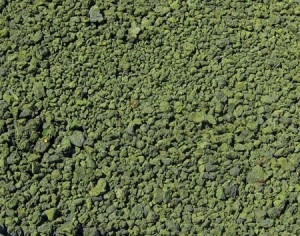By: Dr. John Kyndt ( Head Scientist of the Renewable Energy Program at Advanced Energy Creations Lab of Moura Tecnologies)

As we have promoted before, algae are a valuable producer of oil and therefore an emerging resource for alternative fuel production. However a major opportunity lies in the use of algae as a protein source for food production.
Of particular interest is the use of algae as feed for farm animals, where the algae are referred to as ‘algae meal’.
An estimated 30% of current algal production is sold for animal feed application, with poultry and fish as the main targets.
Dried algae cake is a source of nutrients for both humans and animals because it has a high protein content, sometimes up to 60% of the dry matter.
In essence, algae are composed of three main components: lipids (oil), carbohydrates (sugars) and proteins. In addition, algae meal is also a rich source of carotene, vitamin C and K, and B-vitamins.
Current technologies that are under development are focusing on extracting the lipids from the algal biomass while leaving the carbohydrates and proteins available for other uses. When extracting the lipids for fuel production, one is left with so called LEA (lipid extracted algae).
The exact composition of LEA depends on the algae species as well as the growth conditions and the lipid extraction methods used.
A number of nutritional and toxicological evaluations have demonstrated the suitability of algae biomass as a valuable feed supplement or substitute for conventional protein sources (e.g. soybean meal, fish meal, rice bran, etc.). A few factors need to be taken into consideration when proposing algae as animal feed:
– PER (protein efficiency ratio) = weight gain per unit of protein consumed by the test animal
– Digestibility = the cellulosic cell wall of the algae causes digestion problems in non-ruminants like humans, but shouldn’t be an issue for cattle. Pretreatment of the algae (e.g. during lipid extraction) is also expected to increase the utilization of the proteins in the algal meal.
– Palatability = often the algal biomass has a slight fish odor, which might turn off human consumers, but prelimary studies with fish, rabbits and cattle seems to indicate that this is not an issue with those animals.
Overall it appears that there is a huge market potential arising for the use of lipid extracted algae (LEA) in the cattle feed industry. In the US, the regulatory pathway is still being paved for using algae meal on a commercial scale for cattle that is intended for human consumption; however as the algae production for other products like fuel is growing these pathways will undoubtedly be more rapidly developed.
Production costs of microalgae just as a protein source is still too high to compete with conventional protein sources. Algae for human consumption are currently only sold as a specialty product in health food stores.
However, if the protein and lipids can be produced and extracted as co-products it drives down the economics for both products. In addition, if animal feed is a target product, the wastewater from the cattle farm can in theory be used to grow the algae, which can then be used as food supplement for the cattle.
Therefore co-location of algae production farms with cattle farms and biorefineries seems like a valuable option to generate an integrated food-fuel system.



[…] Source: https://algaeforbiofuels.com/algae-animal-feed/ AKPC_IDS += "467,";Popularity: unranked [?] […]
Grasses can be grown and re-grown, with less nutrient requirement than harvesting whole plants, and C4 grasses also have the advantage (in theory) of a more efficient carbon fixing pathway.
We need to know the adress and price of LEA (lipid extraced algae ), with many thanks.